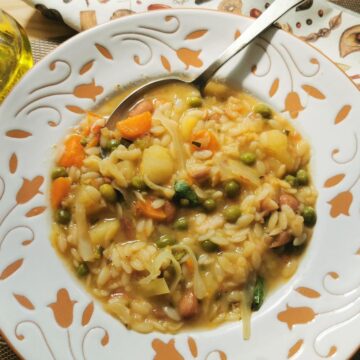This hearty minestrone Milanese is a super nutritious Italian vegetable soup from Lombardy. It is thicker than most minestrone soups and full of healthy seasonal vegetables, protein-rich beans, and aromatic herbs. Add rice or pasta, and serve it the Italian way with grated Parmigiano and a dash of extra virgin olive oil.
What is minestrone?
Minestrone is basically a hearty thick vegetable soup made with seasonal vegetables, plus, some type of pork (pancetta, guanciale, speck, sausage), and bread, rice or pasta. Versions of minestrone can be found throughout Italy.
The history and origins of minestrone.
Minestrone has very ancient origins. Apparently, the Ancient Romans made a rudimentary version with onions, garlic, carrots, asparagus, lentils, mushrooms and what they could find at the time, boiling all the ingredients in water.
Some ingredients have been added over the centuries as a result of the conquests and discoveries made by the Romans and Europeans, such as potatoes and tomatoes which arrived in Italy only after the discovery of the Americas in the sixteenth century.
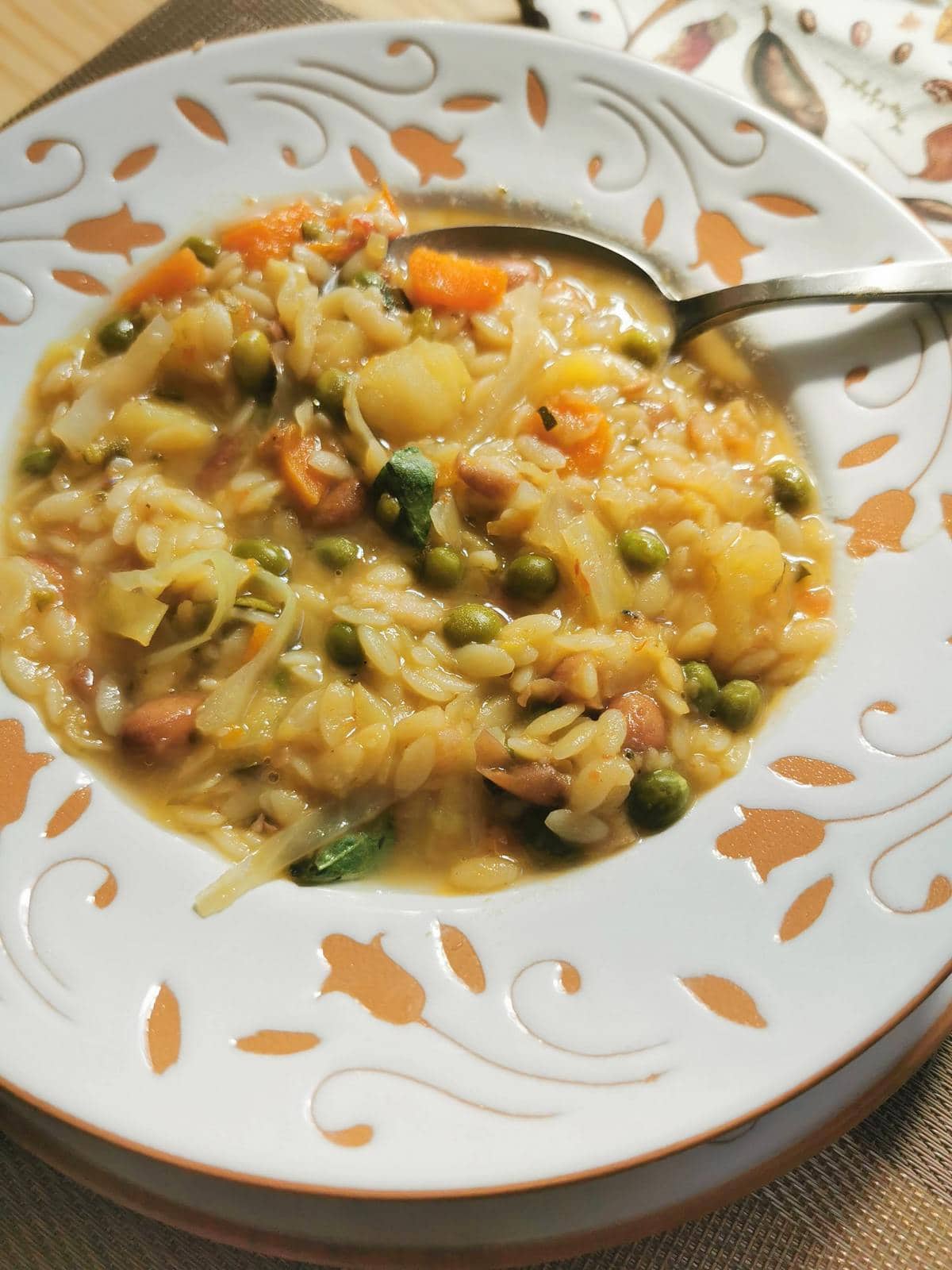

Minestrone was once a staple one plate meal for the rural Italian population, who often made it with seasonal vegetables that were no longer really fresh. They also added ingredients like legumes which required long cooking and bulked it out with rice, pasta or bread to make it more filling.
Today, minestrone remains a staple meal for Italian families. However, it’s no longer a dish for the poor but one that is enjoyed throughout the country because of its nutritional value as much as how delicious it is.


What is minestrone Milanese?
Minestrone Milanese is the version of minestrone that comes from Milan and Lombardy. There, it is eaten both hot in winter and room temperature in summer. It includes quite a long list of ingredients which are added to the pot in various stages.
So, it’s not difficult to make but does take a while to prepare and cook. However, it’s totally worth the time. Your family will love it!


Ingredients, substitutions and tips for Milanese minestrone.
Vegetables and herbs.
Carrots: I used 3 medium sized organic carrots and cut them into small cubes.
Zucchini: Zucchini is usually added to minestrone Milanese in summer, when they are in season. Although nowadays, we can find them almost all year round. I used 2 organic zucchini and cut them into small cubes.
Green celery with some of the leaves: Green celery is usually thinner than white celery and, in Italy, it comes with leaves. If you can’t find it, use white celery. You need to cut the celery into small pieces too.
Fresh sage: Sage adds a lovely slightly bitter herbal flavor to dishes. Instead of sage, you can also use marjoram. Fresh herbs are better than dried. If you only have dried, use just half a teaspoon.
Onion: I used a normal yellow onion, but a sweet red onion works well too.
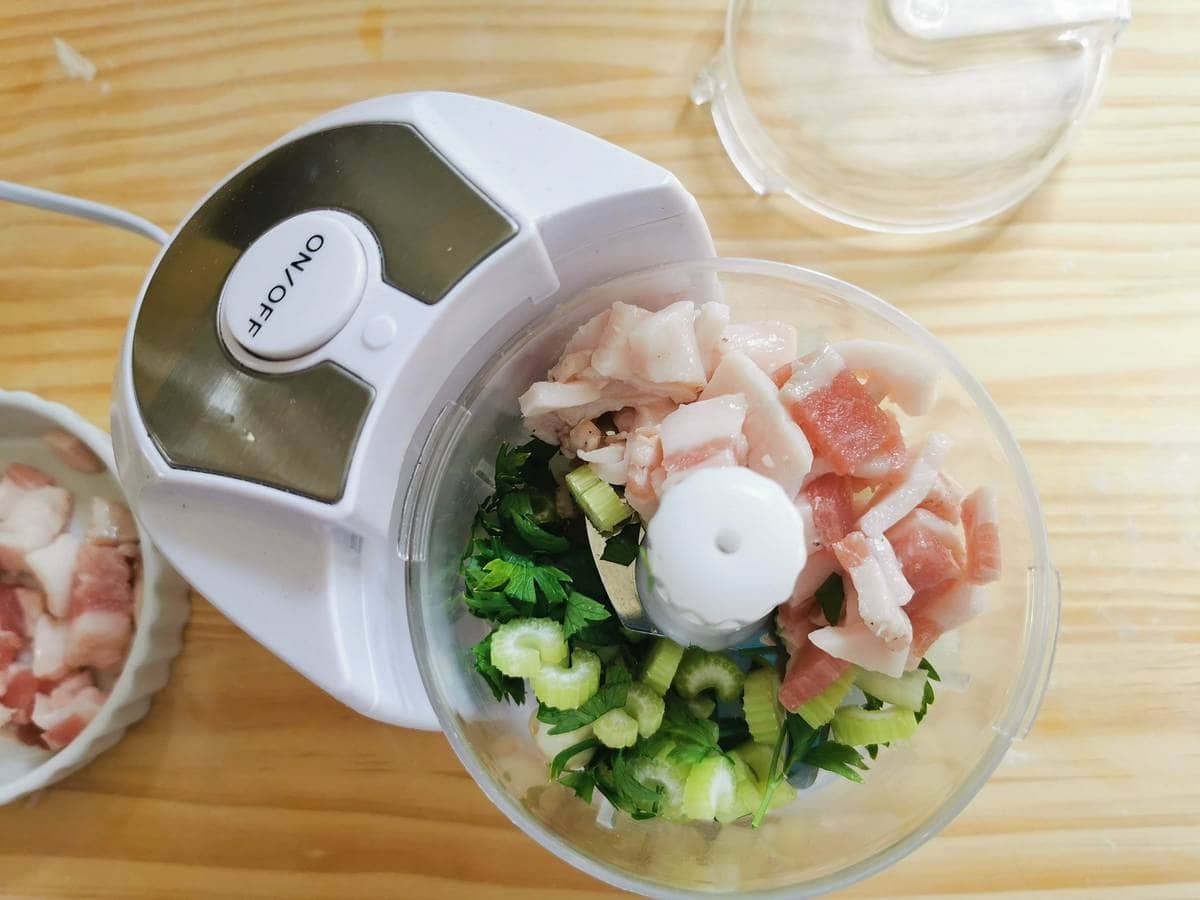

Potatoes: My potatoes actually came from my garden! Waxy potatoes (red potatoes) or boiling potatoes (white potatoes) are the best to use in soup. These potatoes will hold their shape and not fall apart.
Peas (fresh or frozen): Once again, I used my own garden produce, homegrown frozen peas. You can use fresh or frozen. Fresh peas require longer cooking and you need to add them to the soup earlier.
Garlic: The garlic is finely minced as part of the ‘battuto’. This is the Italian version of the French mirepoix. However, in this Milanese minestrone, the battuto contains guanciale, garlic, celery and parsley.
Fresh parsley: Parsley is used in the battuto mentioned above and added to the minestrone before serving. Fresh parsley is better than dried.
Tomato: In summer, a ripe tomato, peeled, cut into cubes and with seeds removed. I used a handful of small datterini tomatoes from my garden, which I didn’t peel. You can also use 2 tablespoons of passata or chopped tomatoes if you don’t have fresh tomatoes.
Fresh basil: Fresh basil adds a lovely fresh herbal flavor to this minestrone. It’s usually included in summer versions, when in season. Dried basil doesn’t have the same flavor.
Cabbage or savoy cabbage: Some people also use Swiss chard instead.


Beans.
Fresh or frozen borlotti beans: (or dried beans, left to soak for at least 12 hours). Also known as cranberry beans, Italian borlotti beans are the legume of choice for minestrone Milanese. You can also use cannellini beans if borlotti aren’t available.
Meat.
Lardo (Italian pig back fat): You can use guanciale or pancetta instead. Many minestrone recipes call for a fatty cut of cured pork. The recipe I followed included guanciale (pork cheek). Both lardo and guanciale can be difficult to find. So, pancetta is a good alternative.
Salt: If you are using guanciale or pancetta, taste before adding salt as both these pork cuts can be salty.
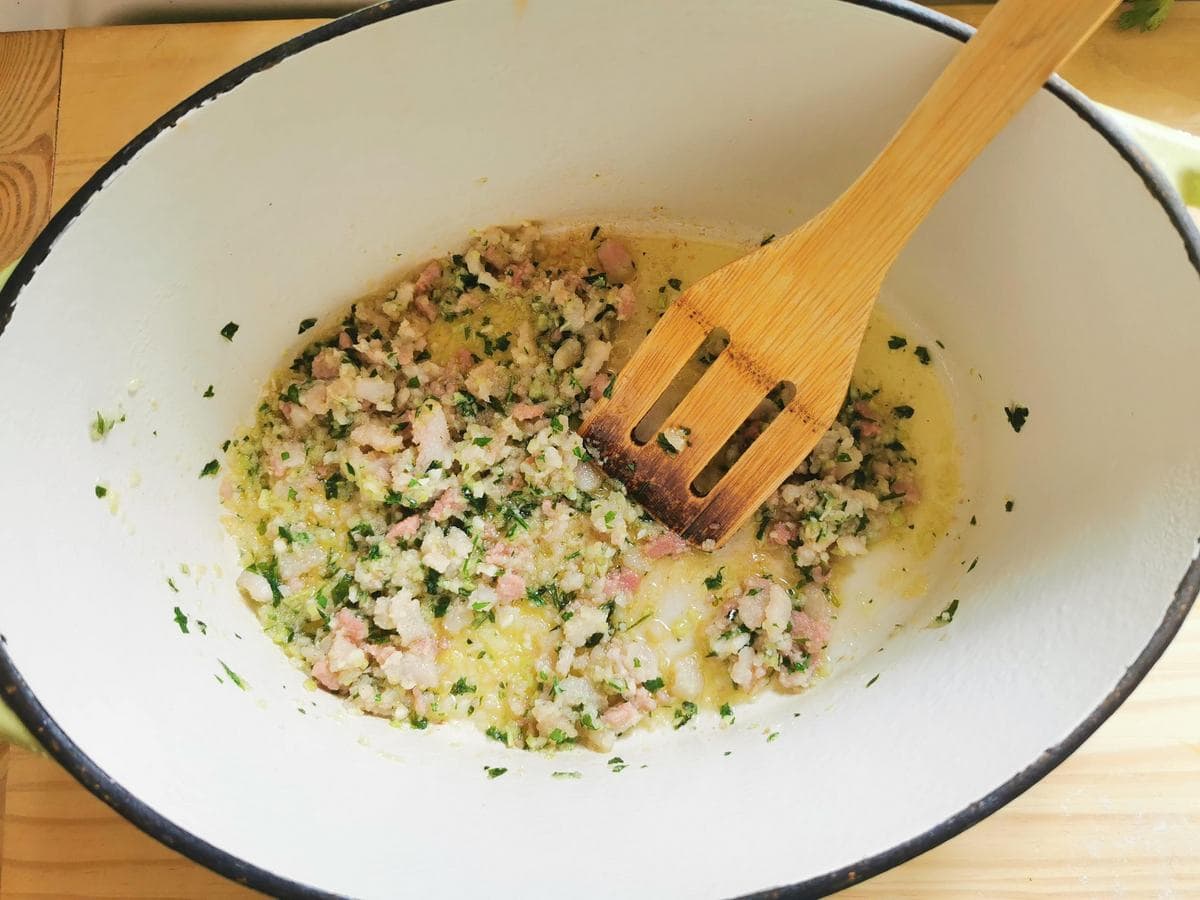

Rice or pasta.
Risotto rice or soup pasta: Minestrone Milanese traditionally includes Italian risotto rice such as Carnaroli, Maratelli, Vialone Nano or Aborio. However, some people use a small soup pasta. I went for orzo (risoni), which looks like rice. I find it lighter and less starchy. Of course, to make this recipe gluten free, you will need to use rice not pasta.
Ingredients for serving.
Parmigiano Reggiano: Italians serve minestrone with a sprinkling of freshly grated Parmigiano. Many also add a Parmigiano rind to the soup during cooking. This adds a wonderful flavor. However, Italian Parmigiano is not vegetarian. So, to make this soup vegetarian, use a vegetarian parmesan.
Olive oil: It’s very common in Italy to add a dash of extra virgin olive oil to minestrone just before serving. Obviously, the olive oil needs to be extra virgin and high quality to get the best aroma and taste. A little olive oil is also used to sauté the ‘battuto’.
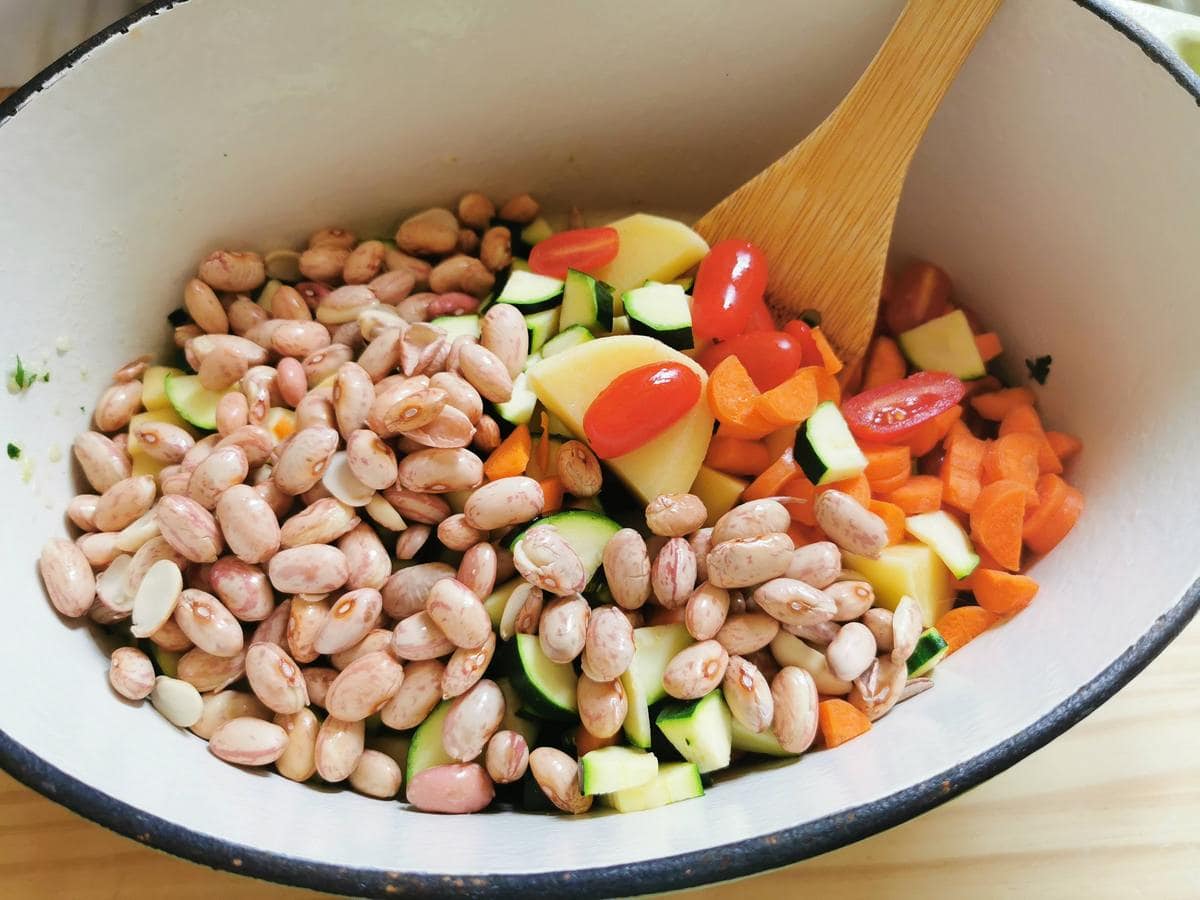

Step by step instructions.
Prepare the ingredients.
First, if using a large fresh tomato, peel it after immersing it in boiling water, remove the seeds and cut into pieces. Wash the zucchini and carrots and cut them into small pieces or cubes. Peel the potatoes and cut them into cubes too. Wash and slice the cabbage.
Cut the guanciale (or lardo) into small pieces along with the celery. Peel and chop the onion and garlic finely. Wash and cut the celery and some of its leaves into small pieces.
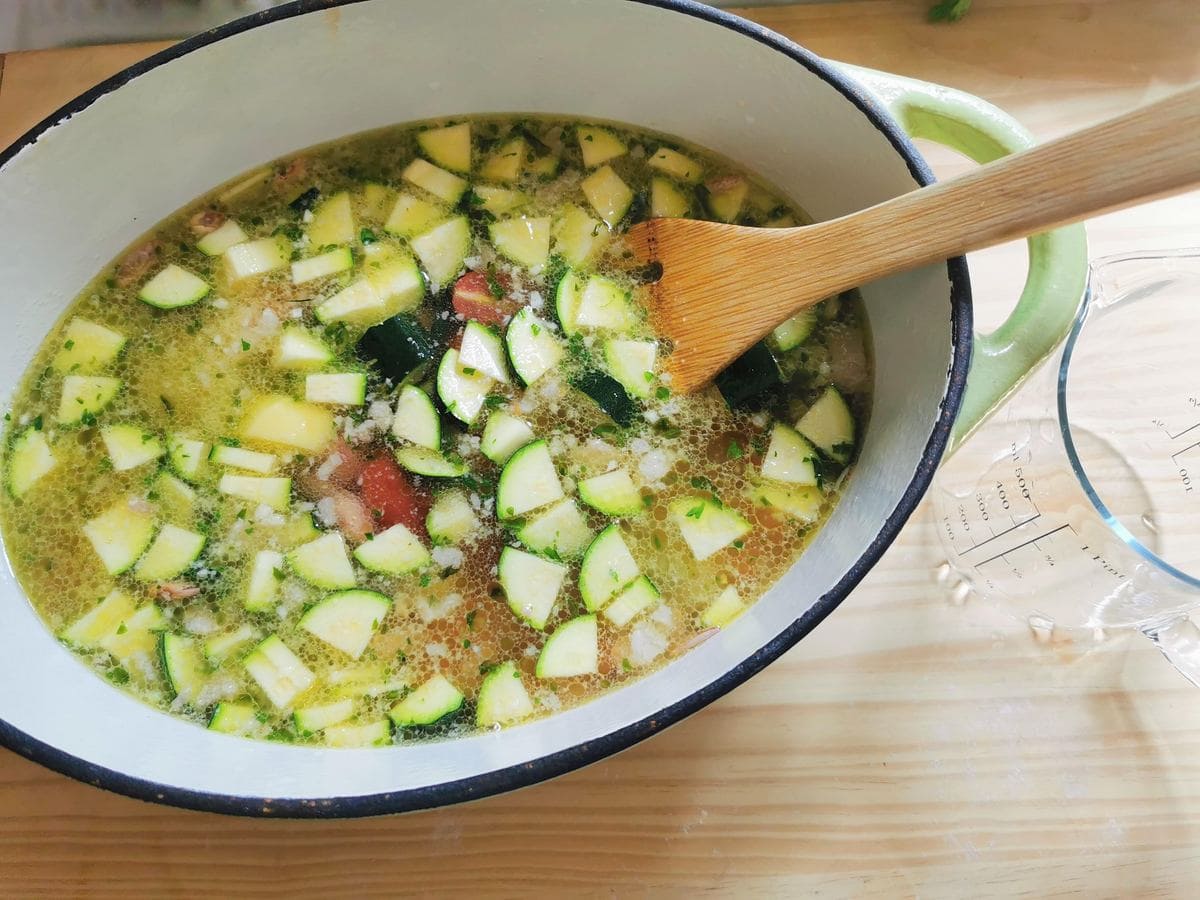

Cook the minestrone Milanese.
Put the lardo or guanciale into a food processor, add ¼ of the onion and the garlic, plus a sprig of parsley and a stick of chopped celery. Blend until you have something close to a paste (see photo above).
Heat a tablespoon of olive oil in a deep soup pan or Dutch oven. Add the lardo ‘battuto’ and sauté until the pork fat starts to render (melt). Next add all the vegetables (except the peas and cabbage) and the uncooked beans.
Cover with plenty of water (about 2 liters) and bring to the boil. Add salt to taste, lower the heat and let the minestrone cook slowly for about 2 hours.
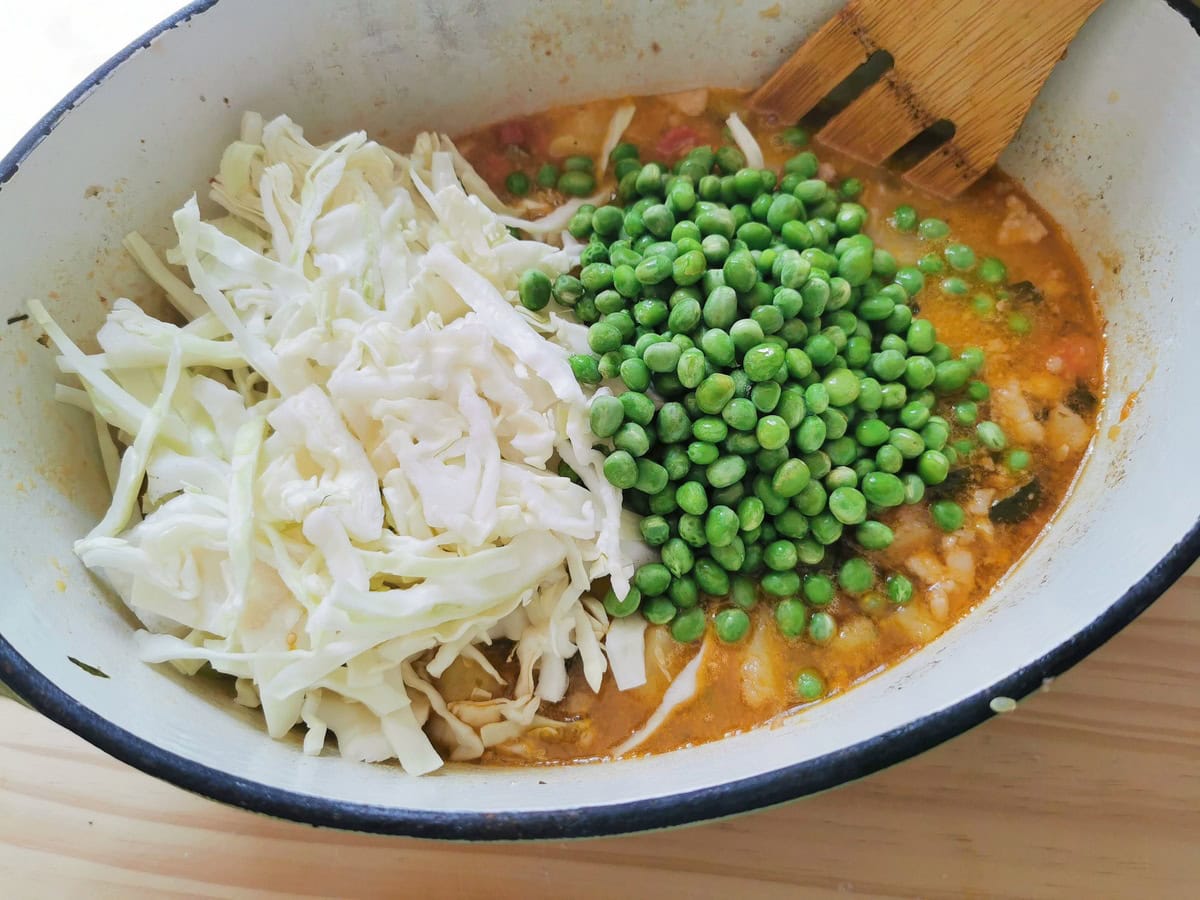

After 2 hours, add the peas and the cabbage cut into strips, plus canned beans if using. Let the cooking continue for about 10-15 minutes and then add the rice or pasta.
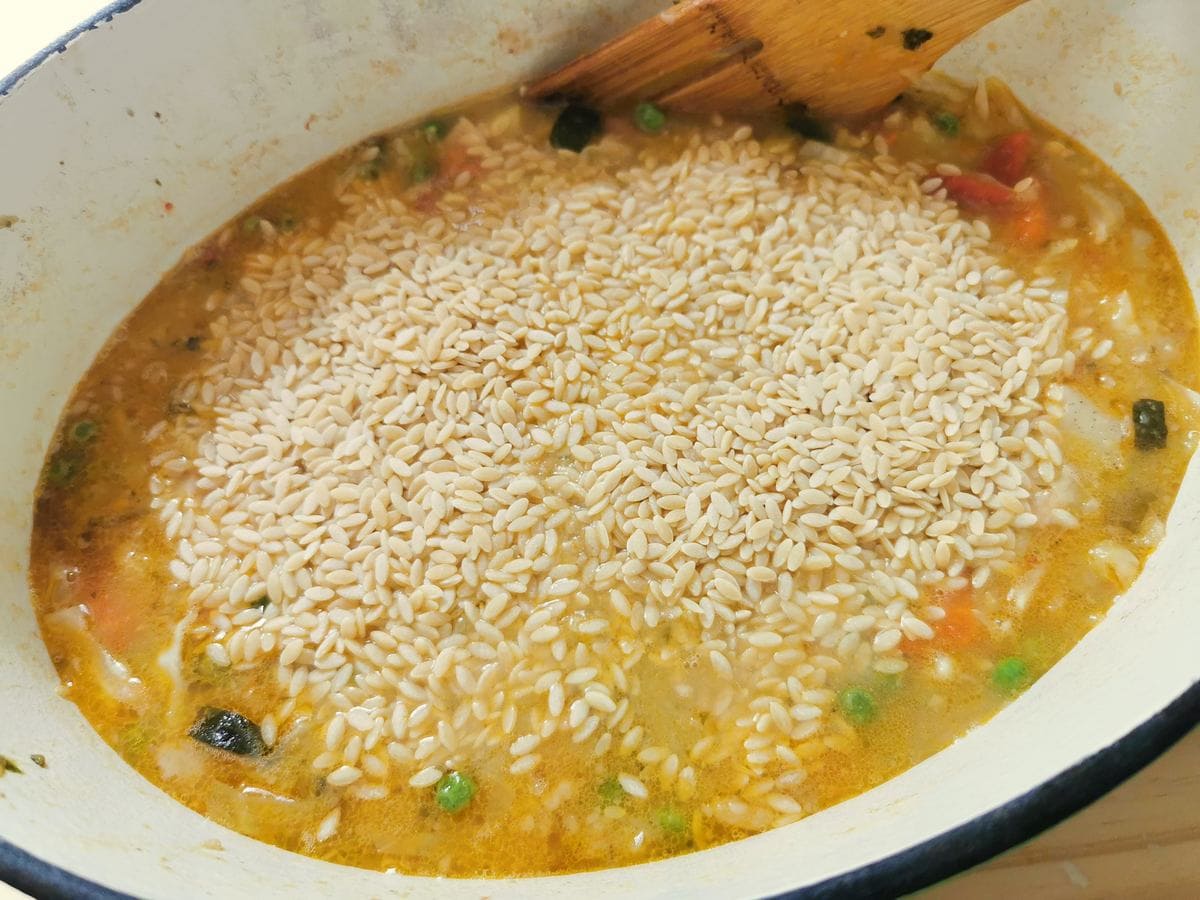

Let the rice or pasta cook for the time indicated on the package (more or less 20 minutes for rice and 10 minutes for the pasta).
A good Milanese minestrone must be very dense and not too liquid. Serve the Italian way with grated Parmigiano and a dash of extra virgin olive oil.


What to do with leftovers.
You can freeze leftover minestrone Milanese for up to 3 months. Store it in a good, sealable freezer friendly container. When ready to reheat and enjoy again, just microwave for a couple of minutes to loosen the soup from the container, then add to a saucepan to thoroughly heat through.
You can also keep your leftover minestrone in the fridge for up to 3 days and reheat it in the microwave or on the stove top.
If you have used pasta in your minestrone Milanese, the pasta tends to absorb much of the liquid. When reheating add more liquid (water or vegetable broth). I have also baked this minestrone with orzo. This is a really delicious way to serve up the leftovers!
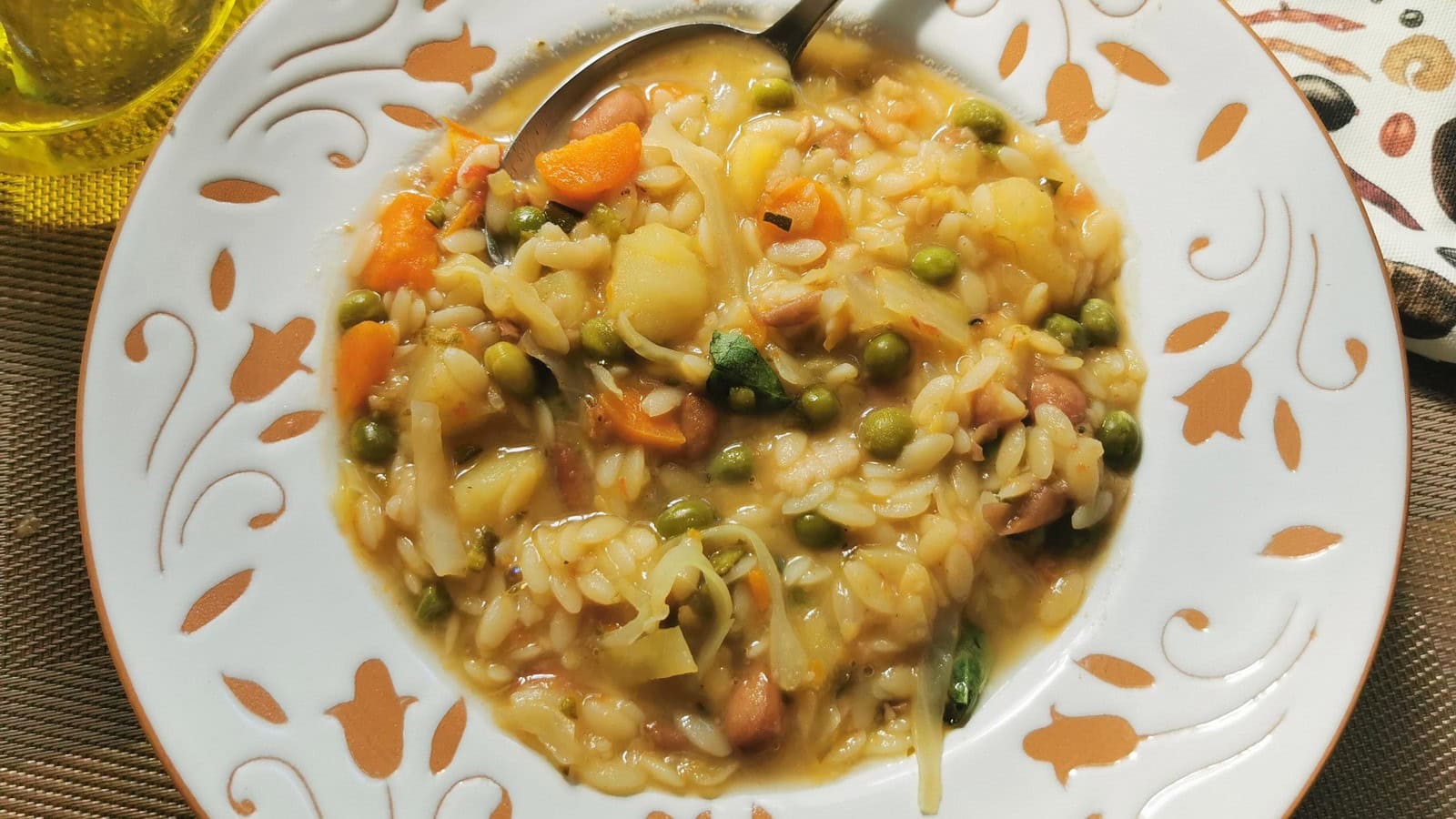

Frequently Asked Questions.
If you use rice instead of pasta, this minestrone Milanese is gluten free.
To make this soup vegetarian, just omit the pork and use a vegetarian parmesan instead of Italian Parmigiano Reggiano. The latter contains animal rennet and is not suitable for vegetarians.
Yes, minestrone Milanese can be frozen for up to 3 months if you keep it in a freezer safe container.
Let me know what you think.
Whether you make this recipe with rice or pasta, and serve it hot or cold, I’m sure this classic Italian vegetable soup will become a staple in your kitchen as much as it is here in Italy! It’s so very hearty, nutritious and delicious!
If you give this minestrone Milanese a try, do let me know how it turns out, either by commenting below or on the Pasta Project Facebook page. And if you feel it’s worth sharing with friends, please do. All your feedback and support is much appreciated!
Buon Appetito!
Pin for Later.
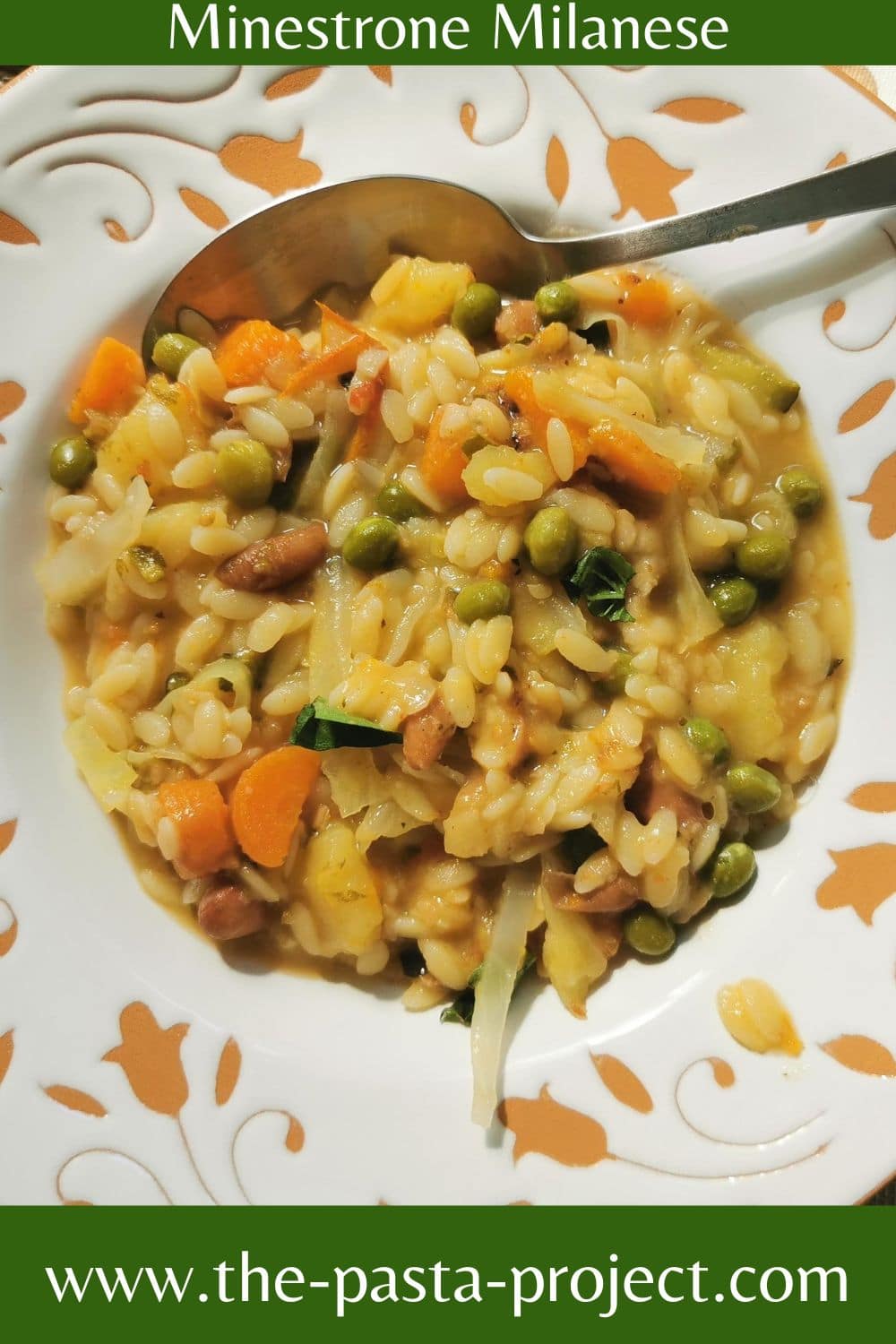

Other pasta soup recipes to check out.
- Tuscan minestrone with orzo
- Minestrone with pesto from Liguria
- Italian fish soup with fried angel hair pasta.
- The best pasta fagioli
- Lentil soup with pasta from Umbria
Reader Interactions

